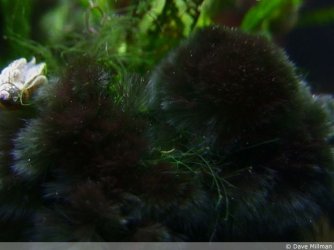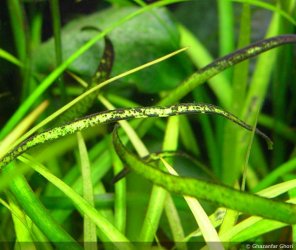I have a serious algae issue that is getting worse and worse every day. My tank is only a few months old, heavily planted and fully cycled. I first noticed this algae a few weeks after the tank was set up, it was growing on the leaves of one of my plants, an Anubias (Think it is Anubias Barteri, but not 100% sure), it looked like black hair around the edges of the leaves. My tank had no fish in at this point and I thought it was caused by the ammonia spikes (from Kleen-off doses), followed by the nitrite and nitrate spikes. Once my tank had completed its cycle I bought 4 Otocinclus as I'd been reading about them online, and a Silver flying fox which was recommended by the store. Within a few days the algae was gone. I rehomed the Flying fox as I found out that it got larger than expected and would not be suitable for my tank. I seemed to be algae free for a week or two, then it started to reappear, the Oto's all seem to have big fat rounded bellies and are just being lazy. The horrible looking algae is now growing faster than before and now seems to be affecting all of my plants, rocks, glass. My plants still seem to be thriving, as well as my fish.
Could it have been the flying fox that almost eliminated the algae before? now that the flying fox has gone it has come back? Should I get more and just keep returning them when they get too large? I don't really want to use any chemicals to get rid of it, or change lighting, everything seems to be thriving as it is already, unfortunately that includes the algae. Obviously it did not just appear from nowhere though, it must of been brought in with the plants, but how do I kill it off without harming the rest of my plants or fish.
80 litre tank with around 65 - 70 litres water.
24w light on timer for 10 hours per day.
5ml API leaf zone added with water changes (Stopped using this week as have heard excess Iron could be causing algae, however algae seems to be growing even faster without it).
No Co2.
Water parameters as of today before water change:
KH 6deg
GH 10deg
PH 8.0
Ammonia 0
Nitrites 0
Nitrates 0 (this is normally around 10, but I don't feed my fish on a Sunday so they can go scavenging for any leftovers, I assume this temporarily stops the nitrogen cycle and excess nitrates are consumed by the plants. Correct???)
Water is then changed every Monday around 40 - 50%.
Could it have been the flying fox that almost eliminated the algae before? now that the flying fox has gone it has come back? Should I get more and just keep returning them when they get too large? I don't really want to use any chemicals to get rid of it, or change lighting, everything seems to be thriving as it is already, unfortunately that includes the algae. Obviously it did not just appear from nowhere though, it must of been brought in with the plants, but how do I kill it off without harming the rest of my plants or fish.
80 litre tank with around 65 - 70 litres water.
24w light on timer for 10 hours per day.
5ml API leaf zone added with water changes (Stopped using this week as have heard excess Iron could be causing algae, however algae seems to be growing even faster without it).
No Co2.
Water parameters as of today before water change:
KH 6deg
GH 10deg
PH 8.0
Ammonia 0
Nitrites 0
Nitrates 0 (this is normally around 10, but I don't feed my fish on a Sunday so they can go scavenging for any leftovers, I assume this temporarily stops the nitrogen cycle and excess nitrates are consumed by the plants. Correct???)
Water is then changed every Monday around 40 - 50%.





